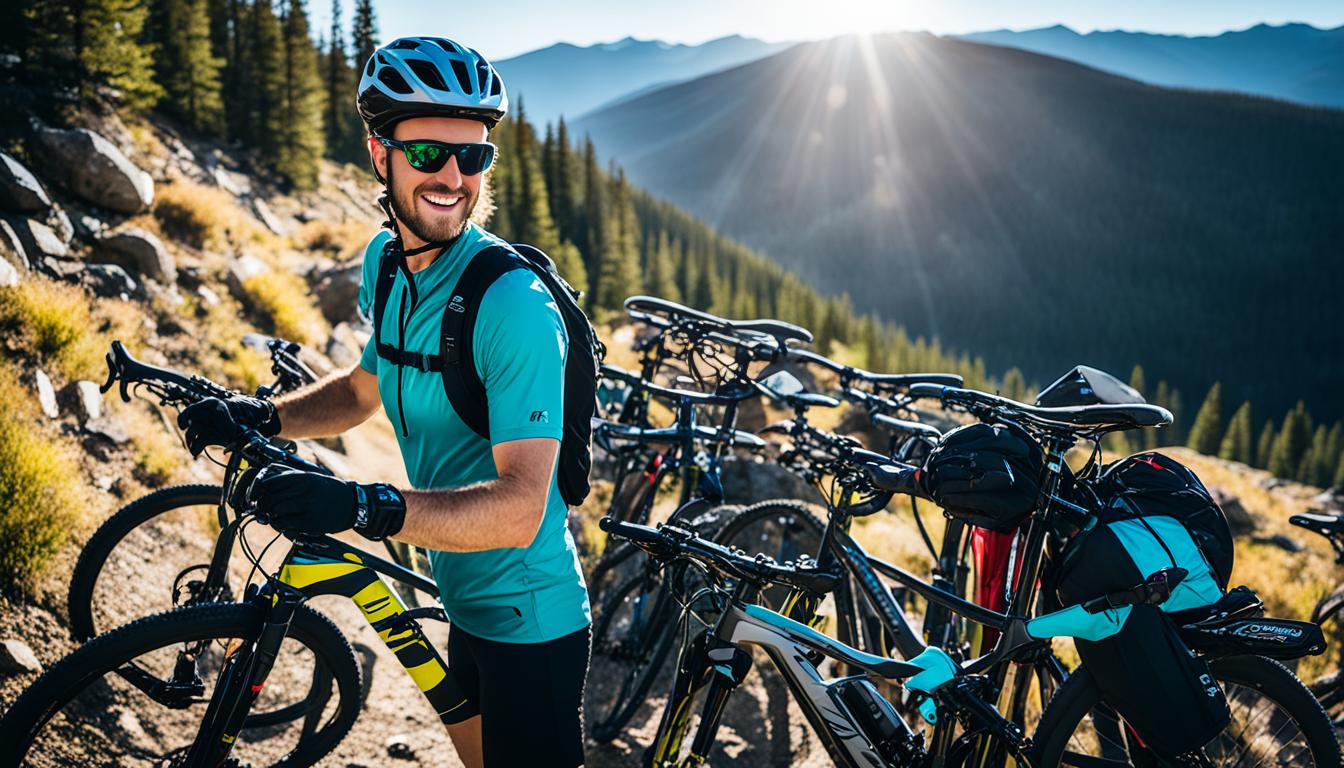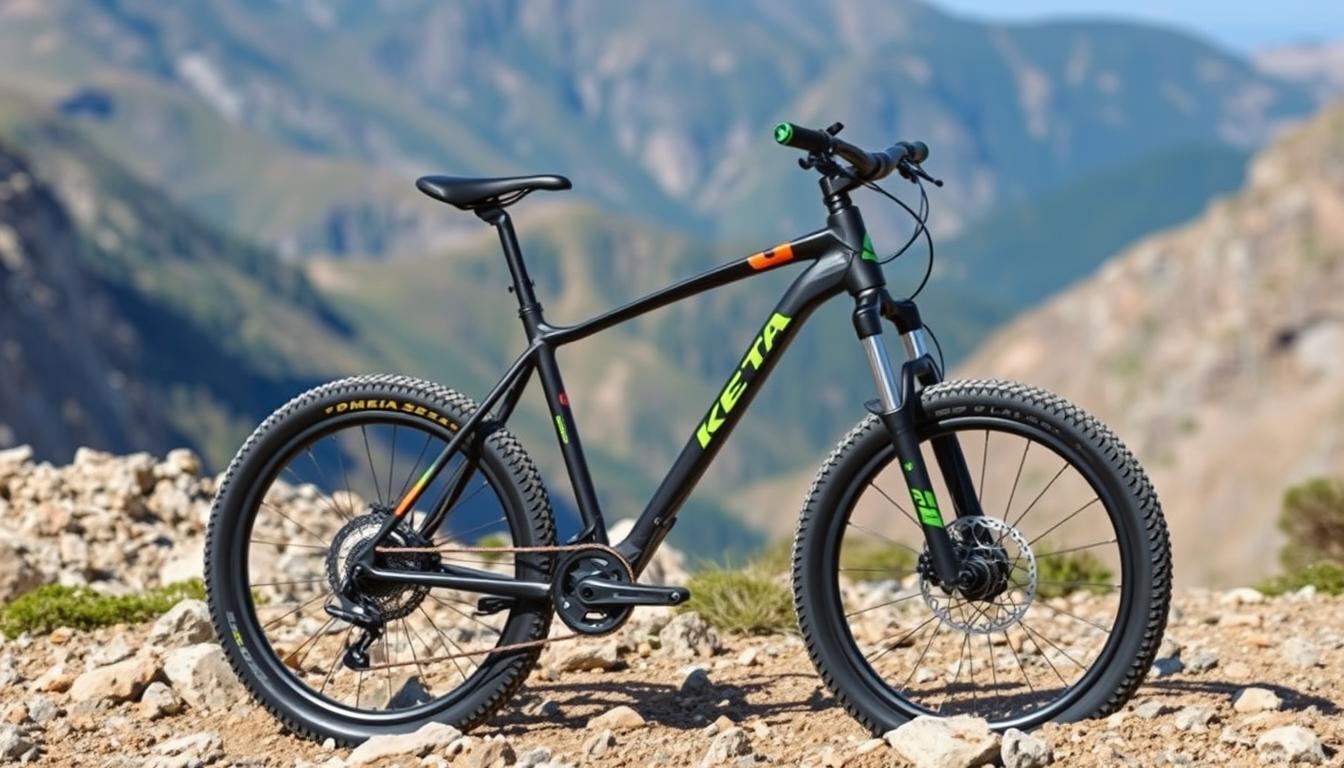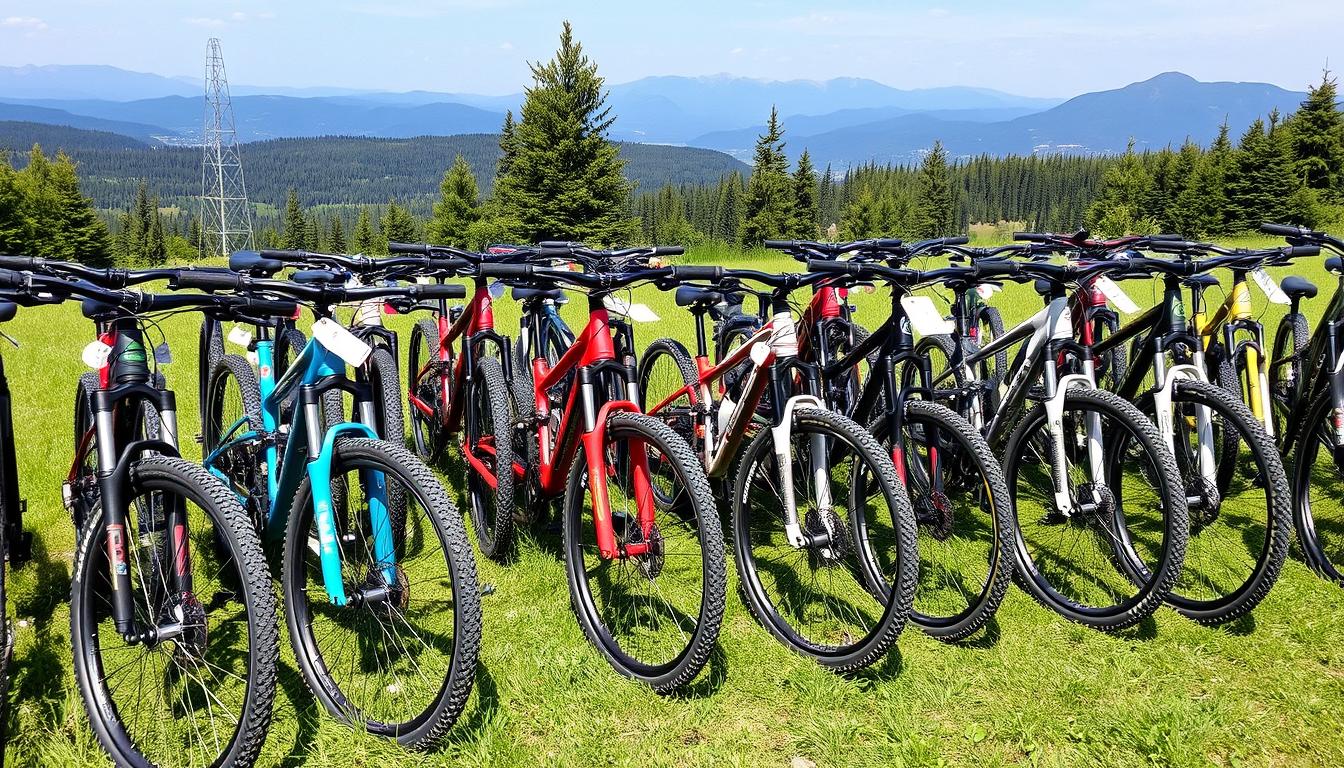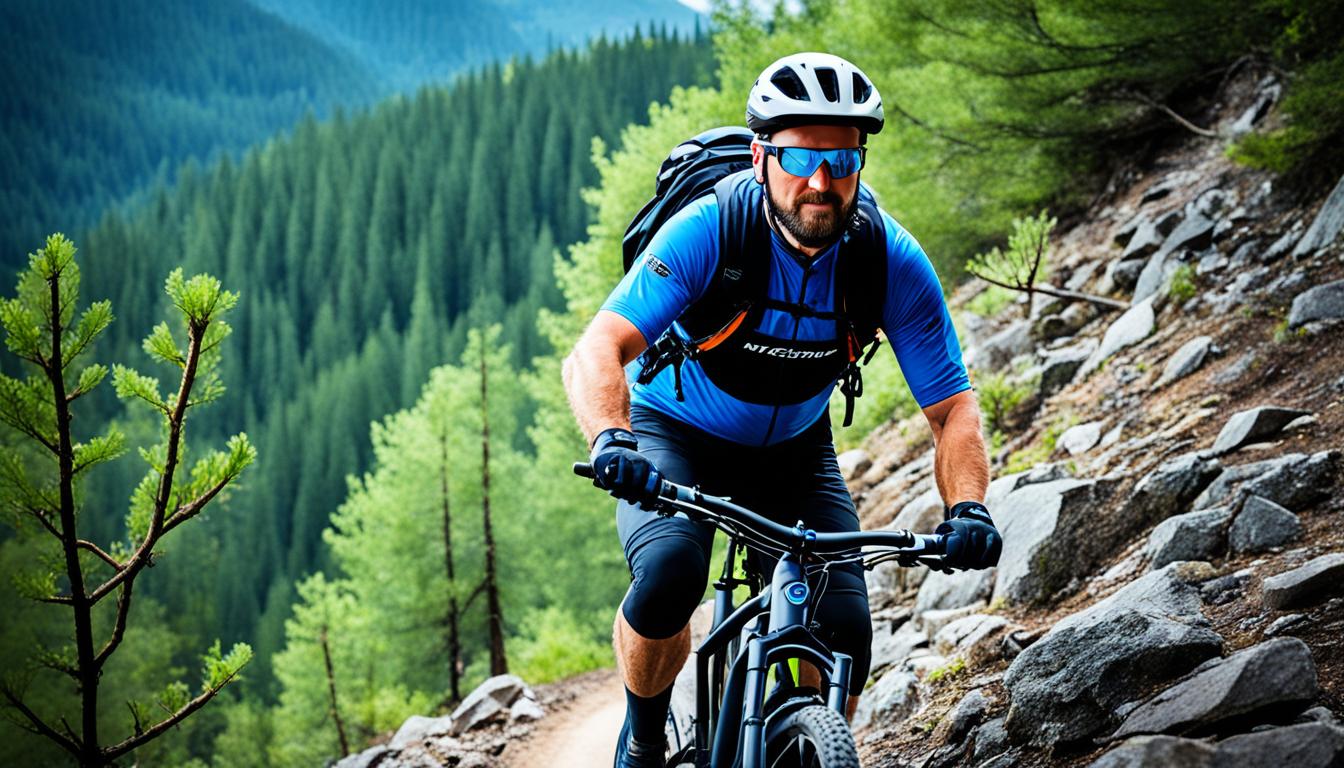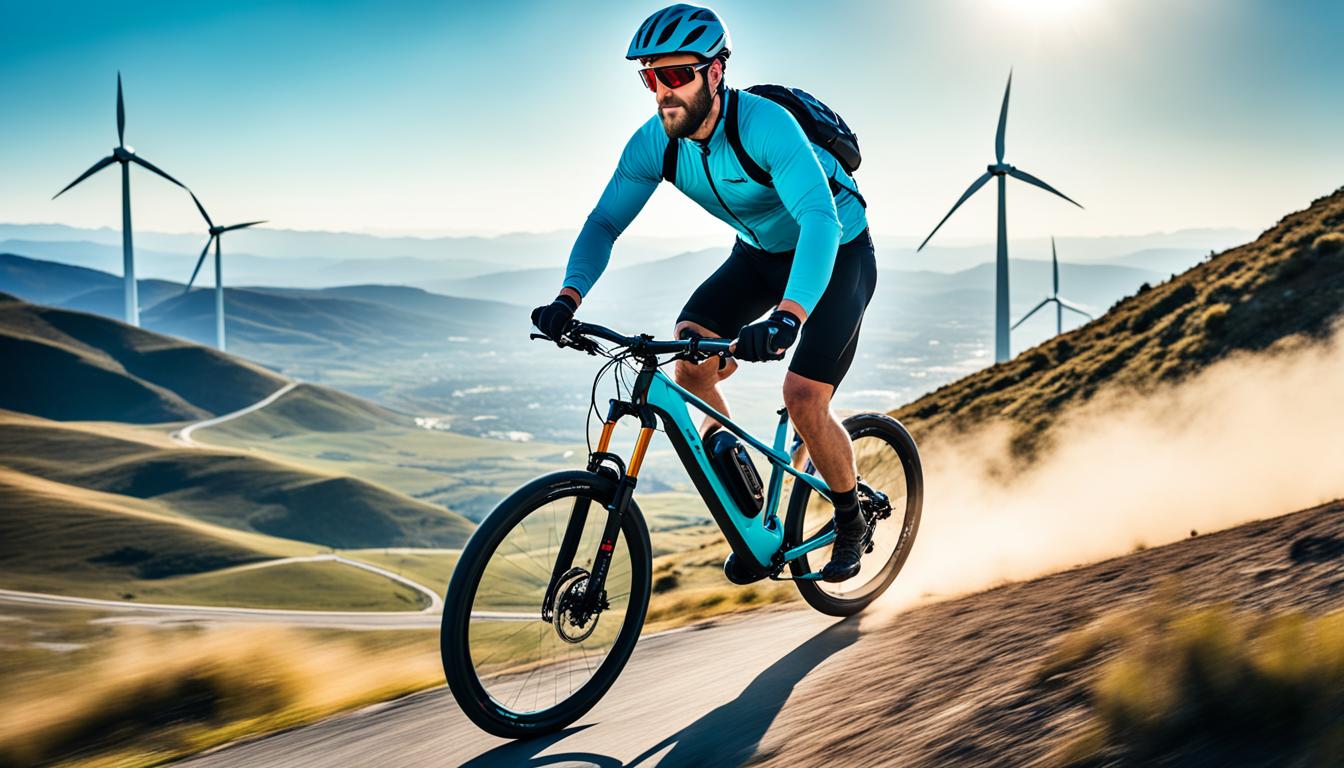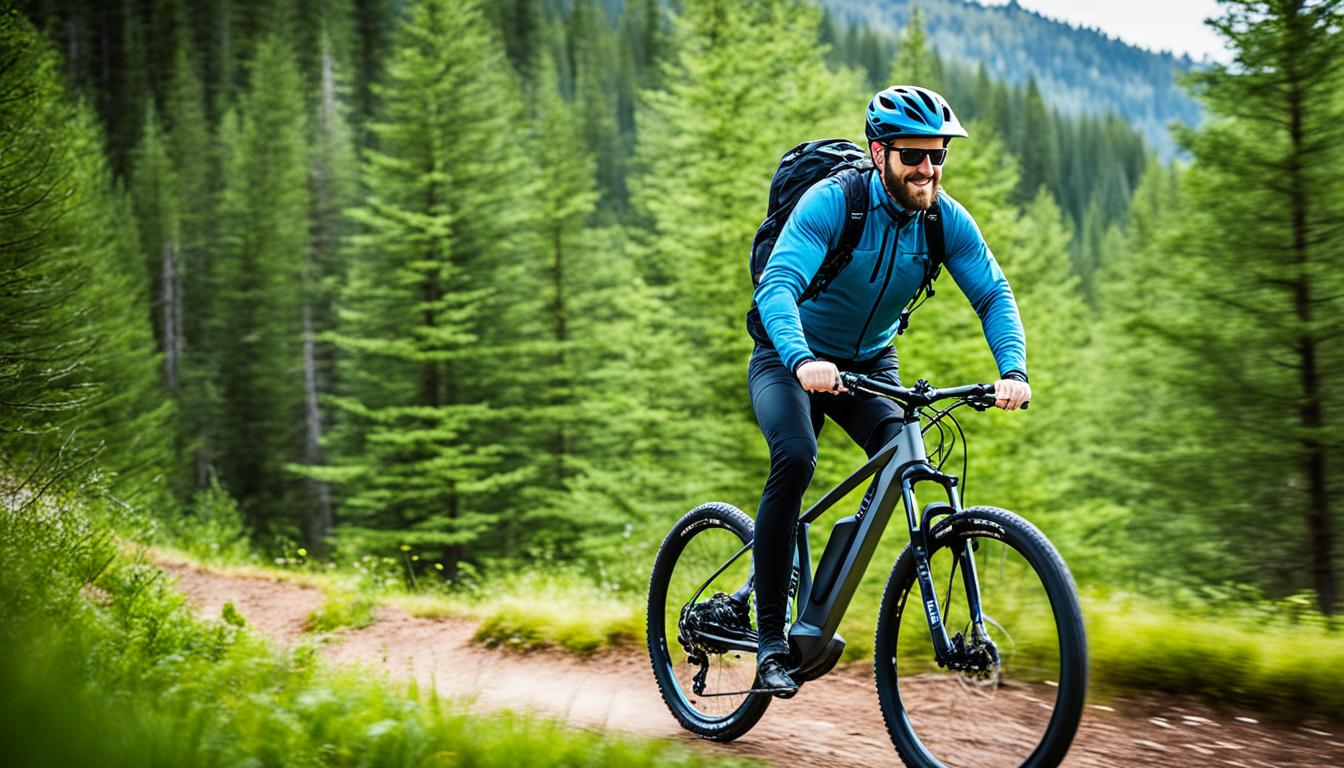The growing love for electric mountain bikes (eMTBs) makes choosing one seem hard. Whether you’re experienced or new to this, picking the right e-MTB matters a lot. It’s vital to understand each model’s unique features to make a smart choice.
We’re here to help with your e-bike journey. This guide covers everything from key bike parts to tips for matching your biking style and the paths you’ll hit. You’ll learn what makes the perfect e-bike for your mountain adventures.
Understanding Electric Mountain Bikes (eMTBs)
Electric mountain bikes, or eMTBs, are a big leap forward in cycling. They’re built for those who love off-road adventures. These bikes have a motor that helps you pedal. This means they can easily tackle tough terrains, perfect for assisted mountain biking adventures.
What is an Electric Mountain Bike?
An electric mountain bike has a small motor, powered by batteries that you can recharge. It offers help when you’re pedalling, not like regular bikes that keep going when you stop pedalling. You must pedal to get the motor to work, and it only helps up to 20 mph. This rule makes sure they fit in on most trails. So, they feel like normal mountain bikes but make riding much easier.
Benefits of Riding an eMTB
Riding an eMTB brings lots of pluses, not just making things easier. Hills become less daunting, so you can ride further and check out new trails. The motor means you can keep up with faster friends, which makes rides more fun for everyone. With different modes, you can adjust the assistance to match what you need for your fitness or how you feel that day. Getting to know these bikes can really change your experience of rough trails.
Key Features of Electric Mountain Bikes
eMTBs have features that make riding better. Motors, batteries, and controllers are key. They affect performance and how we use bikes.
Motor Types and Positions
eMTB motors come as mid-drive or hub types. Mid-drives are at the bike’s middle. They improve climbing and handling. They feel more natural, great for serious riders.
Hub motors are often in cheaper bikes. They can make the bike feel off-balance. They might also get too hot on big hills.
Battery Capacity and Range
eMTB batteries range from 540Wh to 900Wh. This affects how far you can go. Weight, assist level, and terrain also play a part. Bigger batteries mean longer rides but add weight.
When choosing a bike, think about battery size and bike weight. Pick one that suits your riding plans.
Importance of the Controller and Display
The controller sits near the handlebars. It changes assist levels. Displays show battery, speed, and more. Some work with smartphones for more options.
This helps riders keep track of their ride. It makes adjusting settings easier.
How to Choose the Right E-Bike for Mountain Biking
Picking the perfect e-MTB calls for a look at how and where you ride. Your riding style and the terrain you aim to tackle are key. Every rider has their own preference, making certain eMTB features more important. The terrain influences whether a bike suits your adventures.
Consider Your Riding Style
What kind of rider are you? Are cross-country paths, tricky trails, or speedy downhills your thing? Cross-country favors lighter bikes for efficiency. Meanwhile, downhill demands durable parts for tough terrains.
Evaluate the Terrain You’ll Be Riding
Knowing your terrain helps pick the right e-MTB. Think about the trails you love. Steep slopes, technical bits, and ground types matter.
They guide you in choosing bike geometry, suspension, and motor size. This ensures you stay comfy and perform well, no matter the trail.
Choosing Between Hardtail and Full-Suspension eMTBs
When you’re picking an electric mountain bike, it’s vital to know the difference between hardtail and full-suspension eMTBs. Each type offers specific features for various terrains and styles of riding.
Pros and Cons of Hardtail eMTBs
Hardtail eMTBs have a fixed rear frame and front suspension. This makes them more budget-friendly. Hardtail benefits include being lighter, needing less upkeep, and having a longer battery life due to better efficiency. These bikes are great for city rides and flat trails.
However, they do have hardtail disadvantages. One is less shock absorption, which can make rough tracks uncomfortable. This might cause less control on bumpy surfaces.
Advantages of Full-Suspension eMTBs
Full-suspension eMTBs come with both front and rear suspension. This feature greatly improves riding comfort. Their full-suspension benefits include better grip, steadiness, and control on tough paths. Though they’re heavier and need more care, they smooth out rough rides. They’re perfect for mountain biking and off-road trips.
Choosing between eMTB types depends on what you like and where you ride. For more details on the two, including cost and upkeep, check out this article.
Understanding Suspension Travel and Its Impact
When we talk about electric mountain bikes (eMTBs), it’s key to understand suspension travel. This is how far the suspension can move. It plays a big role in how the bike performs. It impacts how the bike feels on different grounds. Different eMTBs have travel types for certain terrains. This ensures the best control and comfort.
Categories of Suspension Travel
Mountain bikes today have suspension travel from 100mm to 170mm. Each type matches a style of riding:
- Cross-Country (XC): Usually 80mm to 100mm, but some are 120mm for tricky tracks.
- Downcountry: Hits the sweet spot between 110mm to 130mm, for good speed and downhill skills.
- Trail: With 120mm to 160mm, it’s right between enduro and cross-country.
- All-Mountain: Normally offers 140mm to 160mm of travel.
- Enduro: Begins at 150mm and can go up to 180mm, made for tough, downhill paths.
- Downhill: Has the most, at 180mm to 200mm, great for steep drops.
Choosing Travel Based on Riding Preferences
Choosing the right suspension travel is all about how you ride. Bikes with long travel, like 150mm to 170mm, are best for hard downhill paths. Bikes with short travel, around 100mm to 120mm, are better for easier trails. Mid-travel bikes offer a balance. They are good at climbing and handle well on rough descents.
Riders need to match their eMTB’s travel with their common trails. Choosing the correct setting can improve your bike’s performance. It helps make each ride more enjoyable and suited to you.
Price Range and What You Get for Your Money
Looking at eMTB prices might feel overwhelming, but knowing your choices helps you decide wisely. There are eMTBs for everyone, from casual riders to adventure seekers. It’s crucial to consider what features matter most to you.
Understanding Budget Options for eMTBs
The Engwe P26, at about £999, is great for leisure riders. It’s affordable and offers good performance for new riders. With enough battery life and motor power, it’s suited for easy trails and relaxed rides.
Differences Between Low-End and High-End Models
Moving up in price shows clear differences between basic and advanced eMTBs. Models between £2,500 and £5,000 have top-notch features. They come with carbon frames, advanced suspension, and better brakes.
These high-end bikes are lighter and handle tough trails well. They also have a longer battery range, up to 150 km. Choosing one means enjoying a lighter bike and stronger build. This is perfect for those who love off-road adventures. Your choice will shape how much you enjoy riding your electric mountain bike.
Popular E-Bike Brands and Models to Consider
The electric mountain bike (eMTB) world is full of choices from top brands. Knowing which well-known e-MTB makers lead the pack helps you shop smarter. This section will discuss the big names and compare eMTB models, focusing on special features and specs.
Top Brands in the eMTB Market
Several brands stand out in the eMTB market. Here are key ones to look at:
- Trek
- Santa Cruz
- Giant
- Specialized
- Polygon
- Canyon
- Cube
- Decathlon
These trusted e-MTB makers offer many models for different types of riders. For example, the Polygon Siskiu T7E and the Decathlon Rockrider E-Expl 520S have unique features. They meet various riders’ preferences.
Comparing Popular Models
Comparing e-MTB models is crucial when choosing. Look at their power, battery life, and how they handle. Below are some models worth a closer look:
- Polygon Siskiu T7E: ALX Enduro alloy frame with 144mm travel, Shimano EP801 600W motor, Shimano 630Wh battery, weighing 24.62kg.
- Decathlon Rockrider E-Expl 520S: Alloy frame with 140mm travel, Brose T 460W motor, and a 500Wh battery; rated 8/10.
- Giant Stance E+ 1: Alloy frame with 125mm travel, Giant SyncDrive Sport 75Nm motor, and EnergyPak Smart 625Wh battery; rated 8/10.
- Decathlon Stilus E-Big Mountain: Alloy frame with 170mm travel, Bosch Performance CX motor, and a powerful Bosch PowerTube 750Wh battery.
- Canyon Neuron:ON 6: Alloy frame with 130mm travel, and Shimano STEPS EP6 motor with a 630Wh battery.
- Cube Stereo Hybrid 140: Carbon frame with 140mm travel, Bosch Performance Line CX motor available with either a 625Wh or 750Wh battery.
To choose the best eMTB, look at bike reviews and expert advice. This helps see which features fit your style best. Make a smart comparison to find your ideal model.
Conclusion
Choosing an electric mountain bike involves looking at how you ride, where you ride, and your budget. This eMTB buying guide talks about the importance of motor power, how much battery you need, and different suspension systems. Remember, low-price electric mountain bikes start at about £1,700. But, the very best ones, with lots of suspension, can cost over £8,000.
When picking an eMTB, it’s crucial to understand battery technology. In the UK, electric bikes usually have batteries from 7Ah to 30Ah. If you plan long rides, go for a bigger battery. Also, how difficult the terrain is, your weight, and steep climbs will impact how long your battery lasts. Knowing this helps you get the most out of your bike, making riding more fun.
By considering these points, you can find an eMTB that’s just right for you. If you’re new to mountain biking, check out this beginners guide. It’s full of helpful advice. Enjoy your biking journey with the perfect electric mountain bike, ready for fun and challenges.
FAQ
What should I consider when selecting an electric mountain bike?
Think about how you plan to ride and where you’ll go. Look for a bike that fits your style, with the right motor, battery, and suspension for you.
What are the different types of motors in eMTBs?
You can find mid-drive motors, great for hills and balance, or hub motors. Hub motors are usually in more affordable bikes.
How far can I ride on a single charge of an e-MTB?
Your ride’s distance depends on the battery (from 540Wh to 900Wh), your weight, the mode you pick, and the land you cover.
What is suspension travel and why does it matter?
Suspension travel measures the shock your bike can absorb. It’s key for a bike’s performance. More travel helps on rough grounds, less makes for quicker response on smooth paths.
What are the advantages of full-suspension eMTBs over hardtails?
Full-suspension eMTBs have both front and back shocks. This makes them comfy and steady on tough trails. They’re great at soaking up bumps for better control when you’re riding hard.
What is the price range for electric mountain bikes?
Entry-level eMTBs start under £2,500. If you’re into serious off-roading, expect to spend £3,500 to £5,000. More expensive bikes offer top-notch parts and performance for enthusiasts.
How do I know which e-MTB brand is best for me?
Check out brands like Trek, Santa Cruz, Giant, and Specialized. Look at what they offer and read reviews to see which bikes fit your budget and riding style.
Is it necessary to read reviews before purchasing an e-MTB?
Definitely. Expert and user reviews shed light on a bike’s strengths and weaknesses. This helps you find the right bike for your riding style and the terrains you want to tackle.
